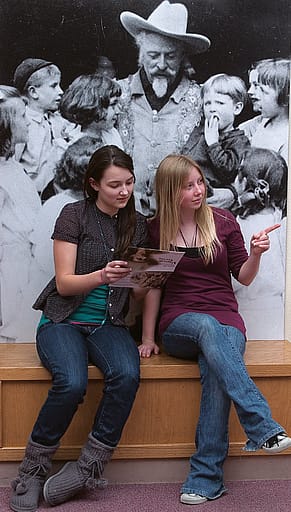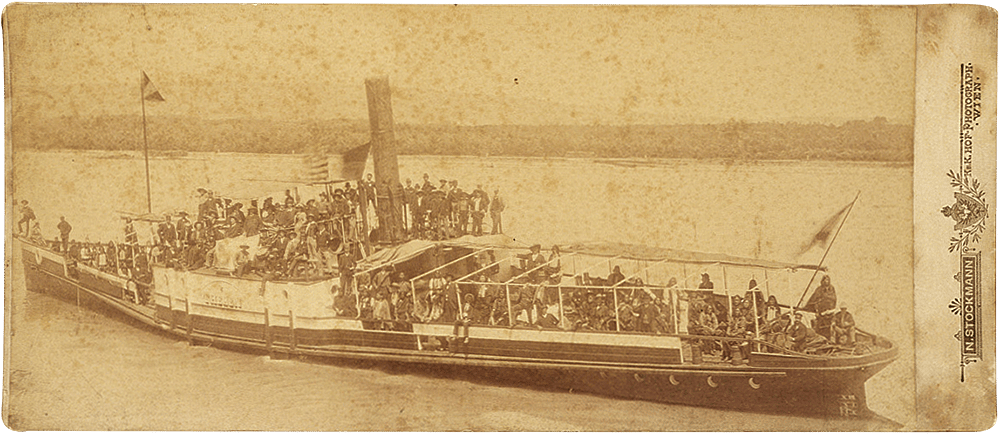
Is Buffalo Bill Relevant to Today’s Audiences and the Millennial Generation? – Points West Online
Originally published in Points West magazine Fall 2012
Is Buffalo Bill Relevant to Today’s Audiences and the Millennial Generation?
By Sienna C. White
On June 15, 2012, the reinstalled Buffalo Bill Museum celebrated its grand opening in true Spirit of the American West fashion. Sienna White, on hand for the festivities, wondered if there was truly a place for William F. “Buffalo Bill” Cody in the hearts and minds of the Millennial Generation. Here is what she concluded:
What do Bing Crosby, Audrey Hepburn, and Lady Gaga all have in common with Buffalo Bill? What’s the common denominator of classic dime novels and modern tabloids? How about similarities between reality television shows and Buffalo Bill’s Wild West? And what, exactly, makes Buffalo Bill pertinent to modern generations?
The Millennials vs. Baby Boomers
As the Buffalo Bill Museum was recently undergoing a re-installation, planners contemplated the role of museums and history in the twenty-first century and asked “How do we make Buffalo Bill and the history of the West relevant to young people? Do they have any interest in such things?” Although Buffalo Bill, or we should say William F. Cody, was born in 1846, he was the most recognizable face in the world by the turn of the twentieth century and is still distinguishable all over the world today. We can easily make the argument that William F. Cody was the original global celebrity and is therefor completely relevant to the celebrity-crazed and technology-oriented Millennial Generation.
According to Dictionary.com, “Millennial” is defined as “a term used to refer to the generation, born from 1980 onward, brought up using digital technology and mass media; the children of Baby Boomers.” Pew Research Center Publication data suggests that the Millennial Generation is “confident, self-expressive, liberal, upbeat, and open to change. They are more ethnically and racially diverse than older adults; they’re less religious, less likely to have served in the military, and are on track to become the most educated generation in American history.”
When one examines the data, it seems that William F. Cody may actually have the potential to be more appealing to the Millennial Generation than to previous generations like the Baby Boomers – particularly if he is viewed as a whole person rather than as simply an icon of the American West. According to a Pew survey, when Millennials were asked which three factors most defined their generation, they answered, “technology, pop culture, and liberalism or tolerance.” Baby Boomers on the other hand, most frequently listed “work ethic, respect, and morals.” Let’s delve a bit deeper into the life of William F. Cody, past the facade of Buffalo Bill, and see which demographic is likely to find him most engaging.
William F. Cody and Technology
For the Millenial Generation, the most important defining characteristic in distinguishing them from previous generations is technology. On that score, William F. Cody certainly has an impressive record. In presenting the American West to the world, he used every communication technology available to him, including recently developed ones such as photography, color lithography, and motion pictures. Buffalo Bill’s Wild West, and the Buffalo Bill Combination before it, employed then state-of-the-art special effects to amaze audiences with things like cyclones and avalanches. The portable dynamo that Buffalo Bill’s Wild West employed to light its grounds and offer evening performances was the largest in use at the time. In an era where trans-oceanic crossings were still a novelty, the Wild West traveled to and from Europe via steamships. It would be a feat even today to get a cast of five hundred Wild West performers, plus all their animals (including bison), across the Atlantic Ocean, but Buffalo Bill did it three times! And, in 1892, the Wild West even experimented with a novel technique for projecting Buffalo Bill’s image onto clouds – anticipating, by 120 years, the new Buffalo Bill Museum’s use of its “helio display” system to project the image of William F. Cody onto an aerial mist.
As an entrepreneur, Cody promoted the development of the irrigation system and dam that allowed Cody, Wyoming, to grow as a town and the Big Horn Basin to develop as an agricultural center. Although these forms of technology seem to be a far cry from the wireless internet, texting, and high resolution photography and video we have today, the amount of technological change Cody witnessed during his lifetime is definitely comparable to the changes witnessed by those growing up at the turn of the twenty-first century.
William F. Cody, Pop Star
Returning to the original question of what Bing Crosby, Audrey Hepburn, and Lady Gaga have in common with Buffalo Bill: All are world famous, yes, but more notably, all are world famous using a stage name or pseudonym. If we were to hear monikers like Harry Lillis Crosby (Bing), Edda van Heemstra Hepburn-Ruston (Audrey), Stefani Joanne Angelina Germanotta (Lady Gaga), or William Frederick Cody, would we experience the same instant name recognition as before? It’s doubtful. We identify with these celebrity stage names circulated by popular media like the dime novel in Buffalo Bill’s time, and the entertainment digests of today.
Given that, what traits do dime novels and modern tabloids share? Both tell wild, primarily fictional stories about people who are far from fictional and, although the comparison may seem a bit of a stretch, these Dime novel stories certainly proved instrumental in cementing William F. Cody’s legacy as Buffalo Bill. They were inexpensive and widely available, and as the stories spread, and the legend grew, Buffalo Bill became the definition of pop culture during the heyday of the Wild West. As an icon, he remained in the public eye well after the show went bankrupt, and the dime novels about him waned in popularity. Likewise, tabloids continue to fan the flame of interest in celebrities like Elvis or Michael Jackson, years after their demise.
Cody share many traits with celebrities like those that fascinate us today, in good ways and bad. He was a friend of royalty, presidents, and other famous personalities. In 1913, he guided the Prince Albert of Monaco on a hunting trip near Yellowstone National Park. Interestingly enough, the Prince was the first sitting head of state to ever visit the United States, and he stayed at a hunting camp just outside the Park near Pahaska Tepee, which Cody owned.

Buffalo Bill also traveled widely, both in the United States and abroad. To this day, in fact, a photo posted at the top of the Eiffel Tower in Paris commemorates Buffalo Bill’s visit there in 1889. The darker side of Cody’s fame, however, include alcoholism, affairs, bad investment choices, and a nasty (and very public) failed attempt at divorce. Finally, Buffalo Bill’s Wild West could even be compared to our own modern inclination toward “Reality TV,” since Cody claimed to portray the West as it truly was even though it was largely an elaborate dramatization.

The Open-Minded Buffalo Bill
Cody’s liberalism and social tolerance may, in fact, be his most unique feature for the time in which he lived. He was remarkably open-minded when it came to social equality, although he would not probably have labeled himself as such. He insisted upon paying women in his Wild West the same wages that male performers received for the same job, and he spoke in favor of the women’s suffrage movement. Ethnically diverse, the Wild West employed performers from every continent and upwards of twenty different nationalities, offering a message of respect, tolerance, and fellowship.
Even though he fought against American Indians during the Indian Wars, Cody came to believe they deserved the right to practice their beliefs and continue their traditions. His conviction was strengthened as American Indians performed in his Wild West. It offered one of the few places that Indians could wear traditional regalia, a practice that the United States government banned on reservation lands. Cody also extended friendship to several notables who were homosexual including playwright Oscar Wilde and artist Rosa Bonheur – a surprisingly accepting gesture given the social norms of the time. This is quite likely the result of his time in the West where people were considered more or less equal, as long as they could take care of themselves and “hold their own.”
It All Comes Together in The “New” Buffalo Bill Museum
It seems that William F. Cody is inherently appealing to the Millennial Generation in his own right, but presentation plays an important role as well. The renovated Buffalo Bill Museum is at the forefront of an emergent trend to make museums more accessible to a growing technology-oriented demographic. This is evident in the increasing number of touch screen displays, interactive computers, and QR (quick response) codes – those black and white squares that we can scan with our smart phones for more information from the Web – incorporated in newer exhibits.
The touch screens stretch the simulations and further exploration beyond what a classic museum setting would allow. This also changes the role of the museum guest from onlooker to participant – exactly what the Millennial Generation as a whole prefers. Many museum exhibits in this day and age also include exhibit-specific “apps,” so instead of a live, charming, tour guide, we can read all about a given exhibit with an application on the screen of our iPhone or iPad. Audio tours available for iPods are becoming exceedingly popular as well. The Millennial Generation appreciates an expects nearly constant change; consequently, even this short attention span is taken into consideration in the design of new museums. Recent museums and renovated exhibition areas have incorporated far more fluid space than was previously the norm; this allows for walls to be put up or taken down and light to be adjusted or even changed completely. All of these charateristics attempt to hold the focus of the constantly multitasking Millennial Generation.
The newly renovated Buffalo Bill Museum does give us a sneak peek into the future of museums, but many questions remain unanswered. Only time will reveal the long-term role of museums in a world where anything can be “Googled” in seconds, and information is expected to be instantaneous. On the other hand, the examination of William F. Cody and his values in a modern light demonstrate that everything about the past isn’t necessarily irrelevant and that the same history can appeal to different audiences by simply using different mediums.

About the author
Sienna White, a Cody, Wyoming, native, spent summer 2012 working as an intern in the Buffalo Bill Center of the West’s Public Relations Department. She has a bachelor’s degree in psychology from the University of Wyoming and is now attending Case Western Reserve University in Cleveland, Ohio, where she studies human rights law. (current as of 2012)
Post 240
Written By
Liz Bowers
Liz Bowers is a Wyoming college student working with the Buffalo Bill Center of the West in summer 2018 to gain experience in Public Relations. This includes activities with social media, review sites, events, writing, and photography. In her spare time, Liz enjoys hiking, trail riding, and stories of all shapes and sizes.
















